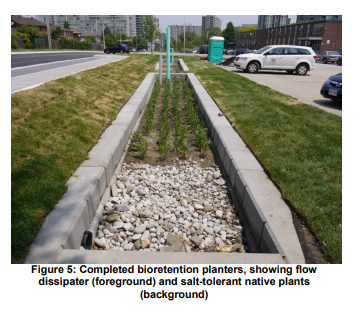Coordination with project partners, stakeholders and local Councillors is important with early LID adoption. Prior to and during the design process, project partners worked together to negotiate the terms of the project, including the roles and responsibilities of each party. To facilitate this process, CVC worked with the Ward Councillor and the local PDSB trustee. Support from these representatives helped ensure that the project had buy-in from both City and PDSB staff. It also led to a successful agreement granting the City access to PDSB property for stormwater management and maintenance activities.
Prior to implementing the retrofit project, Elm Drive consisted of a roadway with soft shoulders and a grass drainage ditch. The stormwater management retrofit was designed to capture stormwater runoff and convey it through permeable pavers and bioretention planters before discharging any remaining runoff to the existing storm sewer system. This was achieved by implementing a road cross-section which is sloped to one side of the road (using a “side shed” configuration) towards the permeable pavers and bioretention planters with all runoff conveyed to LID features via overland flow. Construction took place over a period of seven months.
Elm Drive is just one of the many projects implemented and monitored by CVC as part of the Infrastructure Performance and Risk Assessment (IPRA) program. IPRA is a multi-year stormwater monitoring program focused on gathering detailed information to evaluate stormwater facility performance in various land use types, climate conditions and development stages. The IPRA program also evaluates the effectiveness of stormwater facilities in flood control, erosion protection, nutrient removal, cold climate performance and the maintenance of pre-development water balance.
The monitoring program is based around a set of objectives that have been developed with an advisory committee consisting of municipalities, provincial and federal environmental agencies, academia, and engineering professionals.
